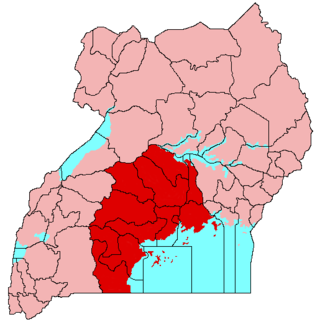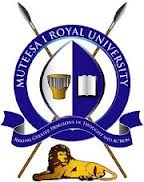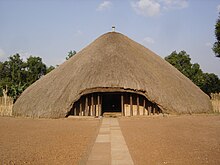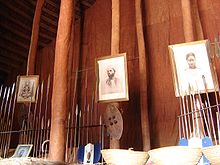
Kampala is the capital and largest city of Uganda. The city proper has a population of 1,680,600 (2020) and is divided into the five political divisions of Kampala Central Division, Kawempe Division, Makindye Division, Nakawa Division, and Rubaga Division.

Buganda is a Bantu kingdom within Uganda. The kingdom of the Baganda people, Buganda is the largest of the traditional kingdoms in present-day East Africa, consisting of Uganda's Central Region, including the Ugandan capital Kampala. The 14 million Baganda make up the largest Ugandan region, representing approximately 16% of Uganda's population.

Sir Edward Frederick William David Walugembe Mutebi Luwangula Mutesa II was Kabaka of the Kingdom of Buganda in Uganda from 22 November 1939 until his death. He was the 35th Kabaka of Buganda and the first president of Uganda from 1962 to 1966, when he was overthrown by Milton Obote. The foreign press often referred to him as King Freddie, a name rarely used in Uganda. An ardent defender of Buganda's interests, especially its traditional autonomy, he often threatened to make the kingdom independent both before and after Uganda's independence to preserve it. These firm convictions also later led to conflicts with his erstwhile political ally Milton Obote, who would eventually overthrow him.

Daudi Cwa II was the 34th Kabaka of the Kingdom of Buganda from 1897 until 1939.

Ronald Edward Frederick Kimera Muwenda Mutebi II is King of the Kingdom of Buganda. He is the 36th Kabaka of Buganda.

Kabaka is the title of the king of the Kingdom of Buganda. According to the traditions of the Baganda they are ruled by two kings, one spiritual and the other secular.
Kimera Walusimbi was Kabaka of the Kingdom of Buganda between 1374 and 1404. He was the third king of Buganda.

The history of Buganda is that of the Buganda kingdom of the Baganda people, the largest of the traditional kingdoms in present-day Uganda.
Lubaga is a hill in Kampala, Uganda's capital and largest city. It comes from the Luganda word okubaga, describing a process of "planning" or "strengthening" a structure while constructing it. For example, okubaga ekisenge means to strengthen the internal structure of a wall while building a house. The name also applies to the neighborhood on the hill.

Muteesa I Mukaabya Walugembe Kayiira was the 30th Kabaka of the Kingdom of Buganda, from 1856 until 1884.
Prince Daudi Kintu Wasajja also called David Wasajja is a prince of Buganda, the largest traditional kingdom in Uganda.
Namirembe is a hill in Kampala, Uganda's capital and largest city. It is also a common name given to girls in several Baganda clans. Namirembe comes from the Luganda word "mirembe" meaning peace. Namirembe loosely translates into Full of Peace. Legend has it that this hill was a gathering place for celebrating peace or war victories.

Muteesa I Royal University (MRU) is a private university in Uganda. It was accredited by the Uganda National Council for Higher Education in 2007 and chartered in 2023. In 2016, Justice Julia Sebutinde was installed as Chancellor of the University, replacing Ronald Muwenda Mutebi II, the founding chancellor who became Visitor of the university.
Banda is a hill that lies in Nakawa Division, within Kampala, the capital of Uganda. Banda also refers to the neighborhoods on the slopes of the hill and between Banda Hill and Kireka, extending all the way to the Kampala-Jinja Highway. The southwestern slopes of the hill are occupied by the neighbourhood known as Kyambogo, and is the location of the campus of Kyambogo University, one of the nine public universities in the country.
Kasubi is a hill in Kampala, Uganda's capital and largest city.

The Baganda also called Waganda, are a Bantu ethnic group native to Buganda, a subnational kingdom within Uganda. Traditionally composed of 52 clans, the Baganda are the largest people of the Bantu ethnic group in Uganda, comprising 16.5 percent of the population at the time of the 2014 census.
Charles Peter Mayiga is a Ugandan lawyer, cultural leader and author. He is the current katikkiro of Buganda, a constitutional monarchy in present-day Uganda. He was appointed to that position by the reigning Kabaka of Buganda, His Majesty Muwenda Mutebi II of Buganda, in May 2013, replacing engineer John Baptist Walusimbi.
Jehoash Ssibakyalyawo Mayanja Nkangi or Joash Mayanja Nkangi was a Ugandan lawyer, civil servant and politician. At the time of his death, he was the immediate past chairman of the Uganda Land Commission. He previously served as a cabinet minister in several ministries in the Cabinet of Uganda.
Naggalabi Hill is a cultural, religious and heritage site where the kings of Buganda Kingdom are crowned.

Butikkiro is the official residence for the Katikkiro of Buganda.
















